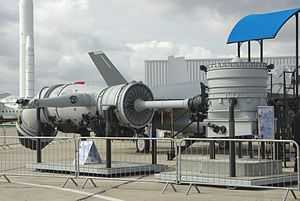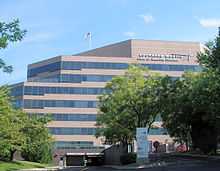Paul Bevilaqua
| Paul Michael Bevilaqua | |
|---|---|
| Born |
May 11, 1945 United States |
| Occupation | Aeronautics engineer |
Paul Bevilaqua is an aeronautics engineer at Lockheed Martin in California. In 1990, he invented[1] the lift fan for the Joint Strike Fighter F-35B along with fellow Skunk Works engineer Paul Shumpert.
Life and career
Paul Bevilaqua earned a Doctorate in Aeronautics and Astronautics (subject: Turbulent wakes) at Purdue University in 1973.[2] This seems to be concurrent with activities as an Air Force Lieutenant at Wright-Patterson Air Force Base (WP-AFB), where he began professional work in 1971.[3] At some point he became Deputy Director of the Energy Conversion Lab at WP-AFB, managed by jet inventor Hans von Ohain. In 1975 Paul left the Air Force to be a Manager of Advanced Programs at Rockwell International's Navy Aircraft Plant.[3] Ten years later, in 1985, he was appointed Chief Aeronautical Scientist at Lockheed, trying to come up with a new line of business.[3]
Hans von Ohain inspired Bevilaqua to think like an engineer rather than a mathematician[4][5] - "in school I learned how to move the pieces, and Hans taught me how to play chess",[6] although he said that about Purdue as well.[2] Ohain also showed Paul "what those TS-diagrams actually mean".[3]
While at WP, Ohain,[7] Bevilaqua and others investigated (see #List of Papers) and patented[8] various flow related concepts, some of them flow multipliers related to vertical take-off and landing.
Invention of LiftFan

In the 1980s, the United States Marine Corps wanted a Vertical/Short Takeoff and Landing (V/STOVL) aircraft with more speed and payload than the Harrier/AV-8B.[9][10][11]
Bevilaqua was working for Lockheed Skunk Works in 1986, when DARPA and the similar British agency launched a program called ASTOVL[11] and issued a 9-month contract to develop concepts[12] for a stealthy supersonic STOVL plane, in accordance with USMC wishes, but without the usual strict technical requirements.[3]
The challenge in combining supersonic flight and STOVL is that an engine powerful enough to lift an aircraft would be too wide to be supersonic, as shown by the Harrier.[3][5] A smaller engine with higher air flow was needed, but seemed impossible.
Inspired by the General Electric CJ805-23 aft-turbofan[13] and the Rolls-Royce tandem-fan,[3][14] an appropriate system seemed to be a dual thrust system with a lift vector at the front and a swivel nozzle at the back for the jet engine, counterbalancing each other.
To leave no stone unturned, all kinds of options were investigated,[13] some even bordering on the ludicrous[2] (using a cannon for lift, transferring power with a laser beam) - Skunk Works employees are no strangers to cartoon antics.[15]
With one month left and no results, he took yet another look at the situation. Three elements were clear:[5]
- a turbine is the best way of extracting power from a jet
- a shaft is the best way of transferring that power forward
- a fan is the best way of converting power to thrust or lift
but that was tried by many[16] and found insufficient - something more was needed.
Exploiting bypass air is the usual way of increasing thrust, but when air flow drops so does pressure, which increases engine speed at the risk of failure. This apparent flaw suddenly turned to a benefit when it dawned upon him that the extra engine power could be put to good use by turning a lift fan.[5] "It took eight months of brainstorming to program the computer in my head, and ten seconds to come up with the idea."[2]
In other words; transforming some of the jet blast to vertical air flow by extracting energy from the hot jet blast with a turbine that turns a shaft driving a fan pointing down, thereby increasing impulse and thus lift, without increasing drag.[2] The transition between horizontal and vertical lift needs to be precisely controlled, and the two lift columns need to be carefully balanced, to maintain control of the aircraft.
The system works similarly to a turbofan, with an extra bypass fan moved and tilted 90 degrees to move cool unburned air vertically instead of horizontally,[12] or a turbine helicopter whose rotor is shrunk and encased. This effect is similar to the previous flow multiplier concepts investigated by Bevilaqua (see #List of Papers) and others (although methods are different), achieving a lift/thrust-ratio of 1.5:1[12] where previous successful aircraft were limited to 1:1 at best.
Paul is not[6] a propulsion engineer, and got help from various Lockheed experts in propulsion, materials and other specialised fields to verify the theories of the concept, which was then patented in 1990-93.[1]
Both DARPA and the Marine Corps liked the concept,[10] and from there it developed through various defense programs such as CALF and JAST[11] into the Joint Strike Fighter Program and through to the X-35B and F-35B. Bevilaqua was a key figure in persuading[10] the Air Force in 1992 that the concept aircraft could be useful as a conventional aircraft without the LiftFan. When the US Navy also came on board,[10] the road was paved for the JSF concept of similar aircraft with different applications, in accordance with JAST Concept Exploration findings.[11]
The practical development and testing of the F135 engine and system was performed by Pratt & Whitney, Allison Engine Company,[17] NASA,[18] Rolls-Royce and others.
One of the key factors in handing the $200B[3] JSF contract to LM is said[19] to be when the X-35B took off from 150feet of runway, went supersonic, and landed vertically in one flight on July 20, 2001[20] - a performance that only the X-35B had done, and only because of the LiftFan concept.
The JSF team was awarded the Collier Trophy 2001[21][22] for the working system, and Bevilaqua received the Paul E. Haueter Memorial Award (American Helicopter Society) in 2004.[23]
List of Papers
- Paul M. Bevilaqua "Evaluation of Hypermixing for Thrust Augmenting Ejectors," Journal of Aircraft, Vol. 11, No. 6, June1974, pp. 348–354
- Paul M. Bevilaqua, "Analytic Description of Hypermixing and Test of an Improved Nozzle," Journal of Aircraft, Vol. 13, No. 1, January 1976, pp. 43–48
- Paul M. Bevilaqua, "Lifting Surface Theory for Thrust-Augmenting Ejectors," AIAA Journal, Vol. 16, No. 5, May 1978,pp. 475–581).
- Paul M. Bevilaqua and Paul S. Lykoudis "Turbulence memory in self-preserving wakes", Journal of Fluid Mechanics, Volume 89, Issue 03, December 1978, pp 589–606
- Paul M. Bevilaqua, Howard L. Toms Jr "A Comparison Test of the Hypermixing Nozzle."
- Paul M. Bevilaqua, John D. Lee, "Development of a Nozzle to Improve the Turning of Supersonic Coanda Jets" (1980)
- Paul M. Bevilaqua One-page Preview of "Joint Strike Fighter Dual-Cycle Propulsion System", Journal of Propulsion and Power, 2005, vol. 21, no5, pp. 778–783
References
- ↑ 1.0 1.1 Bevilaqua et al. Propulsion system for a vertical and short takeoff and landing aircraft, United States Patent 5209428. PDF of original, 1990
- ↑ 2.0 2.1 2.2 2.3 2.4 Purdue Awards, Purdue University website, retrieved December 2009. Archived March 20, 2012 at the Wayback Machine.
- ↑ 3.0 3.1 3.2 3.3 3.4 3.5 3.6 3.7 Field, Karen Auguston. The man with the fan, Design News, 22 February 2004. Retrieved January 2010. Archived October 8, 2010 at the Wayback Machine.
- ↑ Diaz, Jesus. From napkin to first supersonic plane, Gizmodo, 22 Apr 2008. Retrieved January 2010. Archived October 8, 2012 at the Wayback Machine.
- ↑ 5.0 5.1 5.2 5.3 Holm, Erik. Interview with Bevilaqua, retrieved from Danish Engineering newspaper December 2009.
- ↑ 6.0 6.1 LM Video
- ↑ Ohain, Hans von. Jet pump or Thrust augmentor, United States Patent 3525474, 25 August 1970
- ↑ List of patents by Paul M. Bevilaqua, retrieved December 2009
- ↑ Durtcne, Major F. S. AV-8B Super Harrier: Separating myth from reality, Marine Corps University Command and Staff College [1988]. Retrieved January 2010. Archived October 19, 2013 at the Wayback Machine.
- ↑ 10.0 10.1 10.2 10.3 Wilson, George C. GovExec: The engine that could National Journal, 22 January 2002. Retrieved January 2010. Archived October 19, 2013 at the Wayback Machine.
- ↑ 11.0 11.1 11.2 11.3 A history of the Joint Strike Fighter Program, Martin-Baker. Retrieved January 2010
- ↑ 12.0 12.1 12.2 Hutchinson, John. Going vertical – developing a short take-off, vertical landing system. Ingenia Online (PDF) August 2004. Retrieved: December 2009. Raw text
- ↑ 13.0 13.1 Short take-off, low funding Flight International, 29 March 1995. Retrieved: 19 September 2010. Archived July 10, 2010 at the Wayback Machine. Quote: "[we] spent three weeks in a room going over every propulsion system ever used"
- ↑ Rolls-Royce Tandem fan engine United Kingdom Patent
- ↑ How the Skunk Works got its name, Lockheed-Martin website. Retrieved January 2010. Archived March 8, 2011 at the Wayback Machine.
- ↑ Hirschberg, Michael J. V/STOL: The First Half-Century, Vertiflite, March/April 1997. Retrieved January 2010. Archived December 11, 2011 at the Wayback Machine.
- ↑ "-as Allison begins JSF lift-fan tests" Flight International, 21 May 1997. Retrieved: 19 September 2010. Archived November 2, 2012 at the Wayback Machine.
- ↑ Lam, David W. "Lift Fan nozzle for JSF tested in NASA Lewis' Powered Lift Rig" NASA, 15 April 1998. Retrieved: 18 September 2010. Archived December 6, 2013 at the Wayback Machine
- ↑ PBS: Nova transcript "X-planes", retrieved January 2010. Archived November 3, 2013 at the Wayback Machine.
- ↑ Kjelgaard, Chris. From Supersonic to Hover: How the F-35 Flies, Space.com 21 December 2007. Archived October 31, 2010 at the Wayback Machine.
- ↑ Collier Trophy; list of winners. Retrieved January 2010
- ↑ Propulsion System in Lockheed Martin Joint Strike Fighter wins Collier Trophy Lockheed Martin press release, February 28th, 2003. Retrieved: January 2010
- ↑ "Paul E. Haueter Award", American Helicopter Society
External links
- Paul Bevilaqua : The shaft driven Lift Fan propulsion system for the Joint Strike Fighter Presented May 1, 1997. DTIC.MIL Word document, 5.5 MB
- F-35B on Global Security
| |||||||||||||||||||||||||||||||
| ||||||||||||||||||||||
